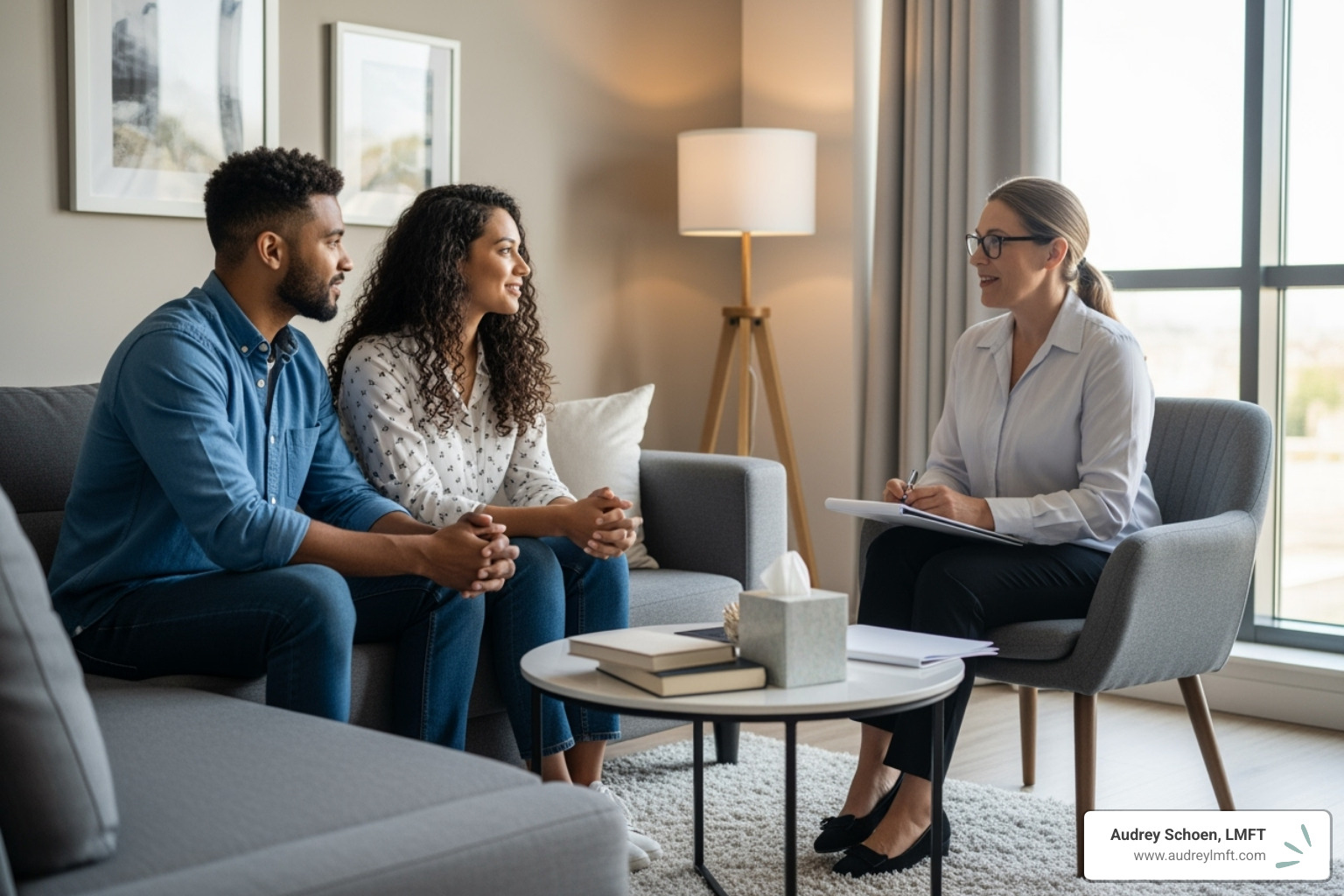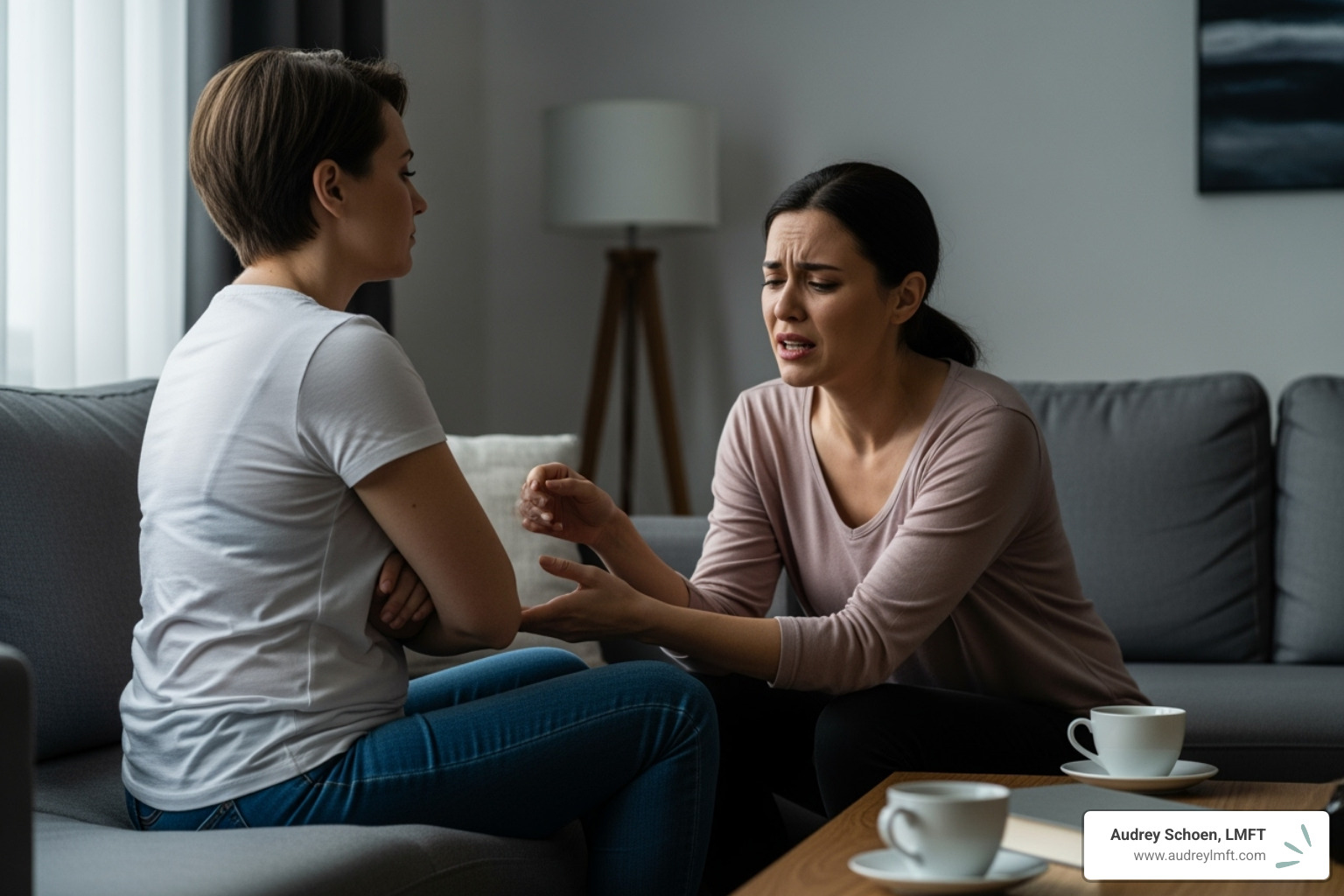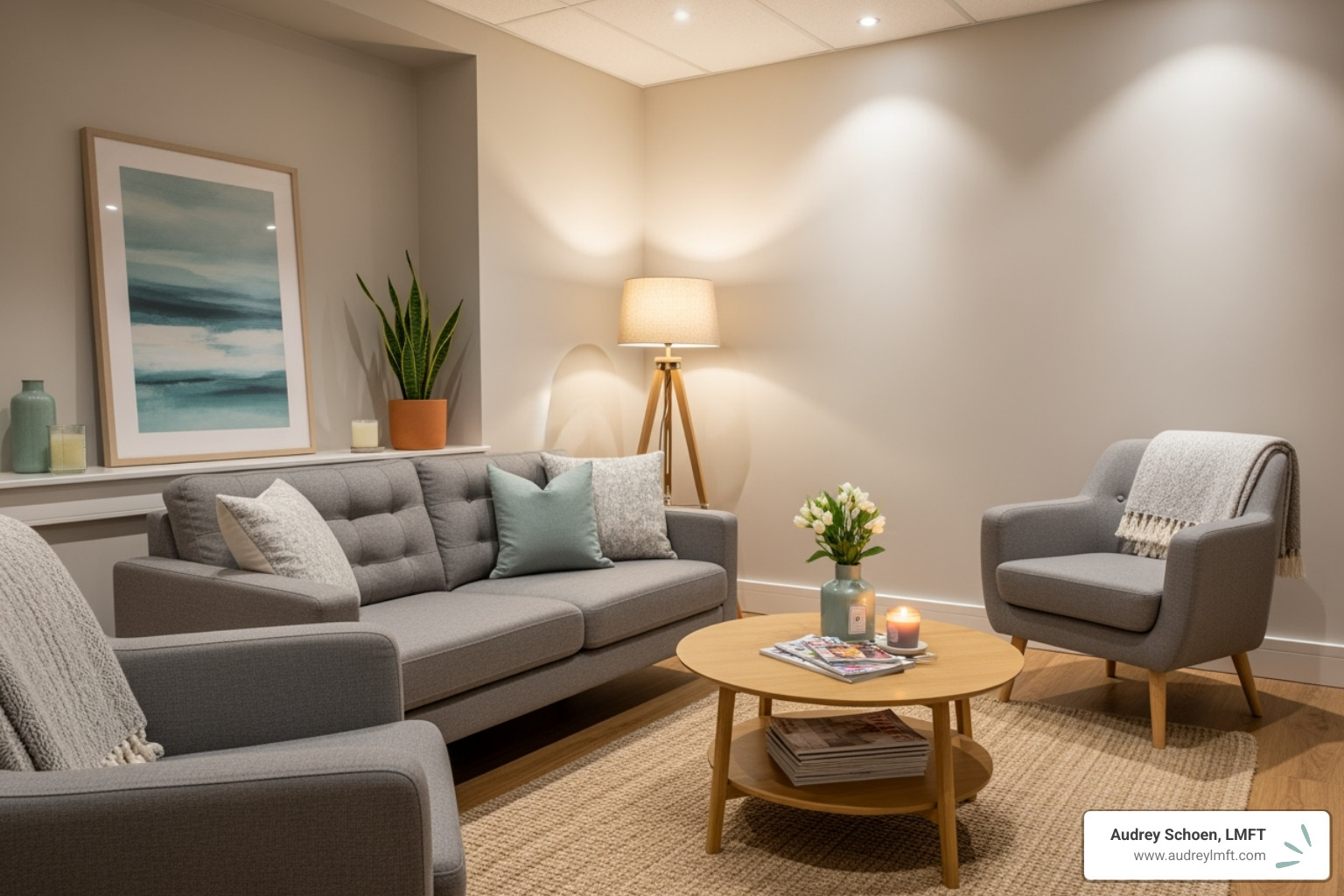Couples Therapy for Communication Issues: Why Your "Communication Problem" Isn't Actually About Communication

If you're reading this, you've probably had the same fight with your partner multiple times. Maybe it starts with something small—dishes left in the sink, a forgotten appointment, or a misunderstood text message. But somehow, it spirals into something much bigger, leaving both of you feeling frustrated, misunderstood, and emotionally drained.
You might think you need better communication skills. You've probably researched techniques, maybe even tried some apps or read self-help books about improve communication. Yet here you are, still having the same arguments, still feeling that familiar knot in your stomach when difficult conversations arise.
Here's what I've learned after years of providing couples therapy and couples counseling in Roseville, CA, and online throughout California and Texas: most communication problems aren't really about communication at all. They're symptoms of something much deeper happening beneath the surface of your relationship.
I'm Audrey Schoen, a Licensed Marriage and Family Therapist and couples therapist specializing in Relational Life Therapy, I work with couples who are exhausted by the constant internal chaos of their relationship conflicts. Many of my clients are anxious, overachieving people-pleasers who are tired of walking on eggshells, avoiding difficult conversations, or exploding in ways that don't feel like them at all.
When couples seek therapy or marriage counseling, they often believe they simply need to enhance communication and develop better communication skills. While effective communication is certainly important for relationship health, the reality is that poor communication is usually a symptom of deeper relationship dynamics that require professional guidance to address effectively.
If this sounds familiar, you're not alone—and more importantly, there's a path forward that goes far beyond learning new ways to talk to each other.
The Real Culprits Behind Relationship Conflict
When couples come to me for couples counseling saying they have communication issues, what they're really describing are the visible symptoms of invisible problems. Think of it like having a fever—the high temperature isn't the illness itself, it's your body's response to an infection that needs treatment.
In relationships, the arguments, misunderstandings, and emotional reactivity are like that fever. They're signals that something deeper is happening in the emotional and psychological landscape of your partnership. Understanding these relationship dynamics is crucial for creating lasting change.
Your Personal History Is Running the Show
Every person brings their entire life story into their relationship. The way you learned to handle conflict, express needs, and navigate intimacy in your family of origin becomes the unconscious blueprint for how you operate with your partner today. These deeply ingrained communication styles and coping skills often operate below our conscious awareness.
For many of my clients—especially those who describe themselves as anxious overachievers—this often means they learned early on that their worth depended on being perfect, keeping others happy, or avoiding conflict at all costs. When these deeply ingrained patterns collide with the inevitable challenges of intimate partnership, the result can feel chaotic and overwhelming.
Maybe you shut down when your partner raises their voice because criticism felt dangerous in your childhood home. Perhaps you become controlling when you feel disconnected because abandonment triggers your deepest fears. These aren't character flaws—they're adaptive responses that once served you but are now creating disconnection in your relationship.
The therapeutic process in couples therapy helps identify these automatic patterns and provides a safe space to explore how past experiences shape present relationship issues. Through therapy sessions, couples can begin to understand the deeper level of their conflicts and work toward healthier ways of relating.
The Dance You Can't Stop Dancing
Every couple develops what I call their "conflict dance"—a predictable pattern of moves and countermoves that keeps them stuck in negative interaction patterns. One partner might pursue while the other withdraws. One might criticize while the other becomes defensive. One might explode while the other shuts down completely.
This dance isn't conscious. It's driven by each person's automatic responses to feeling threatened, misunderstood, or emotionally unsafe. The tragedy is that the very strategies you use to protect yourself often push your partner further away, confirming your worst fears about relationships and love.
For anxious, people-pleasing types, this might look like avoiding conflict until resentment builds to an explosive point, or constantly trying to fix your partner's emotions while neglecting your own needs. The harder you try to keep the peace through poor communication patterns, the more disconnected you both become.
Couples therapy techniques focus on identifying these negative interaction patterns and helping both partners develop effective communication skills to break free from destructive cycles. Through couples counseling, you can learn to recognize when you're falling into old patterns and choose more constructive responses.
When Your Nervous System Takes Over
One of the most overlooked aspects of relationship conflict is what happens in your nervous system when you feel emotionally threatened. Your brain doesn't distinguish between a charging tiger and your partner saying something that triggers your deepest insecurities—it responds with the same fight, flight, or freeze response.
When you're in this activated state, the rational, loving part of your brain goes offline. You can't access empathy, creativity, or genuine problem-solving abilities. Instead, you're operating from a place of pure survival, which makes meaningful communication nearly impossible.
This is why learning communication skills often feels ineffective in the heat of the moment. When your nervous system is hijacked by perceived danger, no amount of "I statements" or active listening exercises can help you connect with your partner in a genuine way. You need coping skills to manage these intense emotional states and create emotional safety in your relationship.

Why Traditional Approaches Often Miss the Mark
Many conventional approaches to couples therapy focus heavily on teaching communication skills and conflict resolution techniques. While these tools can be helpful, they often fall short because they're trying to solve a surface problem without addressing the root causes.
It's like trying to stop a leaky roof by constantly mopping the floor instead of fixing the actual hole. You might manage the immediate mess, but the water keeps coming in because the underlying issue remains unresolved.
The Limitation of Skills-Based Approaches
Traditional communication training often assumes that people simply don't know how to express themselves clearly or practice active listening effectively. While this can sometimes be true, more often the issue is that deep emotional triggers and unconscious patterns are preventing people from using effective communication skills they actually already possess.
You probably know, intellectually, that you should use "I statements" instead of accusations. You understand that interrupting your partner isn't helpful. But when you're in the grip of old fears and automatic responses, accessing that knowledge feels impossible.
This is particularly challenging for my clients who tend to be high achievers. They're used to being able to think their way out of problems, so when relationship issues persist despite their best efforts to apply techniques they've learned, they often become even more self-critical and frustrated.
Many couples try relationship communication exercises and active listening exercises, but find these tools don't work when emotions are running high. This is because the deeper emotional patterns and triggers need to be addressed before communication techniques can be truly effective.
When Insight Isn't Enough
Some therapeutic approaches focus heavily on helping couples understand their patterns and gain insight into their dynamics. While understanding is valuable, insight alone rarely creates lasting change for relationship satisfaction.
You might clearly see how your childhood experiences are affecting your relationship. You might recognize your part in the negative cycle. But if the emotional charge around those old wounds remains unprocessed, you'll likely find yourself falling back into the same patterns despite your best intentions to improve communication.
This is why I integrate trauma-informed approaches like Brainspotting and Accelerated Resolution Therapy into my couples counseling work. These modalities help process the underlying emotional material that keeps you stuck, making it possible to actually implement the changes you want to make and communicate effectively with your partner.
How Relational Life Therapy Transforms Relationships
The approach I use with couples, Relational Life Therapy (RLT), recognizes that lasting change requires both emotional healing and practical skill development. But RLT goes further—it focuses on helping each person become more authentic and accountable in their relationship.
RLT is based on the understanding that healthy relationships require emotional maturity from both partners. This doesn't mean being perfect or never having conflicts. It means being willing to look honestly at your own contribution to problems and take responsibility for changing what you can control—yourself.
This couples therapy approach creates a supportive environment where both partners can examine their relationship dynamics and develop more effective strategies for connection and conflict resolution.
Phase One: Understanding Your Dance
The first phase of RLT involves thoroughly mapping out your specific conflict pattern. During therapy sessions, we identify exactly how each partner contributes to the cycle that keeps you stuck and disconnected. This process requires actively participating in honest self-examination and being willing to see your role in relationship problems.
This isn't about assigning blame or determining who's "more wrong." It's about developing a clear, shared understanding of what happens between you when things go sideways. For many couples seeking couples therapy, simply seeing their dance clearly for the first time is profoundly relieving—suddenly, what felt chaotic and personal becomes predictable and workable.
During this phase, we also establish clear goals for your relationship. What would success look like for both of you? What would you be getting that you're not getting now? For my clients who often struggle with perfectionism and people-pleasing, this goal-setting process helps them connect with what they actually want rather than what they think they should want.
I also introduce essential ground rules and preliminary skills like strategic time-outs and basic boundary setting. These coping skills help create immediate stability while we work on the deeper issues. We also practice active listening techniques and develop listening skills that support emotional connection even during conflict.
A crucial element of Phase One is amplifying both the negative consequences of staying stuck and the positive possibilities that become available when you change your patterns. This helps generate the motivation and commitment needed for the real work ahead, particularly for any partner who might be reluctant to engage in the therapeutic process.
Phase Two: Healing Individual Wounds
Phase Two focuses on addressing the historical experiences and traumas that fuel your current triggers and automatic responses. This isn't about spending months exploring your childhood—it's targeted, efficient work designed to reduce the emotional charge around past experiences so they stop hijacking your present relationship.
We examine how the adaptive strategies you developed to survive your early experiences are now creating problems in your adult partnership. Perhaps learning to be hypervigilant helped you stay safe in an unpredictable childhood home, but now it makes you constantly scan for signs that your partner is upset with you. Maybe becoming a perfectionist earned you love and approval growing up, but now it makes emotional intimacy feel impossibly risky.
This phase often includes individual therapy sessions using Brainspotting or Accelerated Resolution Therapy to process specific traumatic experiences or deeply held beliefs that contribute to relationship distress. These approaches can create rapid shifts in how you experience yourself and your partner, often leading to immediate improvements in your daily interactions and better communication.
The goal isn't to eliminate all your triggers—that's neither possible nor necessary. Instead, we work to reduce their intensity and frequency while developing your capacity to recognize when you're being triggered and respond more consciously rather than automatically. This creates the emotional safety necessary for healthy communication to flourish.

Phase Three: Building New Skills
Once we've addressed the underlying emotional barriers, Phase Three focuses on developing concrete skills for managing conflicts, communicating effectively, and maintaining connection. This is where traditional communication techniques become much more effective because you're no longer trying to use them while emotionally activated.
We practice specific tools like the Feedback Wheel, which provides a structured way to address problems without falling into blame or defensiveness. Unlike dialogue-based approaches that focus on mutual understanding, the Feedback Wheel is specifically designed to allow one partner to bring up an issue and provide their partner with a clear pathway to repair.
This approach recognizes that not every conflict needs to become a lengthy discussion where both people share their perspectives. Sometimes, what's needed is for one person to be heard and for their partner to offer what they can to address the concern. This creates a more supportive environment for resolving conflicts effectively.
We also work on the art of repair—those crucial moments after a conflict when you have the opportunity to reconnect and rebuild trust. For couples who have been stuck in negative cycles for months or years, learning to repair effectively and manage conflicts constructively can feel miraculous.
During this phase, couples learn to enhance communication through practicing active listening, developing empathy, and becoming more aware of nonverbal cues like body language and eye contact. These communication exercises help improve problem-solving abilities and create deeper emotional connection between partners.
The Power of Individual Healing Within Couples Work
While couples therapy addresses the relational dynamics between partners, individual therapy often plays a crucial role in creating lasting change. This is where approaches like Brainspotting become invaluable for supporting the overall couples counseling process.
Understanding Brainspotting
Brainspotting is a powerful therapeutic approach that helps process trauma and emotional wounds by accessing the brain's natural healing mechanisms. It works by identifying specific eye positions that correspond to activated neural networks related to traumatic or emotionally charged experiences.
For couples work, Brainspotting is particularly effective because it can quickly reduce the intensity of individual triggers that contribute to relationship conflicts. When your nervous system is less reactive to your partner's behavior, you have much more access to choice in how you respond and can communicate effectively even during challenging moments.
Many of my clients experience significant shifts after just a few Brainspotting sessions. Old triggers that used to send them into emotional tailspins become manageable. Past wounds that kept them guarded and defensive begin to heal. This individual work often creates a boost of quick progress that feels highly motivating and helps sustain momentum in the couples therapy process.
The Integration of Individual and Couples Work
I often weave individual therapy sessions into the couples counseling process, particularly during Phase Two when we're addressing historical trauma and triggers. This allows for deeper processing of sensitive material while maintaining focus on how individual healing serves the healthy relationship.
For anxious, overachieving clients who tend to intellectualize their experiences, Brainspotting provides access to emotional processing that doesn't require talking through every detail of past experiences. This can be particularly relieving for people who have spent years in talk therapy without experiencing significant change.
The goal is always to help you bring a more regulated, authentic version of yourself to your relationship. When both partners are doing this work, the transformation can be profound. Individual therapy sessions support the overall couples therapy by helping each partner develop better coping skills and emotional regulation.

Practical Tools That Actually Work
Beyond addressing deeper emotional patterns, effective couples therapy must provide practical tools for daily interactions. However, these tools work best when they're grounded in an understanding of what's really happening beneath surface-level conflicts.
The Feedback Wheel: A Different Approach to Conflict
One of the most powerful communication exercises I teach couples is the Feedback Wheel. Unlike communication approaches that focus on dialogue and mutual understanding, the Feedback Wheel is specifically designed to allow one partner to address a problem and provide their partner with a clear pathway to repair.
The process involves four steps:
- What I saw or heard: Describing specific, observable behaviors without interpretation
- What I made up about it: Acknowledging the story you created about those behaviors
- How I feel about what I made up: Expressing emotions without blame
- What I'd like: Making a specific, doable request
This approach recognizes that not every issue needs to become a lengthy discussion. Sometimes what's needed is for one person to be heard and for their partner to offer what they can to address the concern. The listening partner's job is not to share their perspective or explain their behavior—it's to understand their partner's experience and offer repair.
For people-pleasers who often struggle to bring up problems at all, the Feedback Wheel provides a safe structure for expressing concerns. For partners who tend to become defensive, it offers a clear roadway for responding helpfully rather than reactively.
This relationship exercise helps couples move beyond poor communication patterns toward more effective communication that actually resolves issues rather than escalating them.
The Art of Strategic Repair
Healthy relationships aren't defined by the absence of conflict—they're characterized by the ability to repair effectively after disconnection occurs. This is one of the most crucial communication skills for long-term relationship success.
Effective repair involves several key elements:
Taking Strategic Time-Outs: When emotions are running high, continuing to engage often makes things worse. Learning to pause the conversation when either partner is activated and returning to it when you're both calmer can prevent significant damage to your connection. This is one of the most important coping skills for couples to develop.
Authentic Accountability: This means taking responsibility for your part in the conflict without deflecting, defending, or making excuses. For anxious people-pleasers, this often means learning to own your impact even when your intentions were good.
Genuine Repair Attempts: These are specific actions designed to rebuild connection after conflict. This might include a sincere apology, a gesture of affection, or simply acknowledging your partner's experience without trying to change or fix it.
Rebuilding Trust: After repeated conflicts, trust often erodes in small, incremental ways. Repair involves not just addressing the immediate issue but also demonstrating through consistent actions that the relationship is a priority.
These couples therapy techniques help partners learn to manage conflicts more effectively and create lasting emotional connection.
Creating Safety for Authenticity
For many of my clients who describe themselves as anxious and people-pleasing, one of the biggest challenges is learning to be authentic in their relationship without triggering their partner's defensive responses or their own fears of abandonment.
This requires creating what I call "relational safety"—a supportive environment where both partners can express their true thoughts, feelings, and needs without fear of rejection, criticism, or retaliation. This emotional safety is fundamental to healthy communication and relationship satisfaction.
Building this safety involves developing skills like emotional regulation, empathetic listening, and non-defensive responding. It also requires addressing individual triggers and wounds that make authenticity feel dangerous.
When both partners feel safe to be real with each other, many communication problems resolve naturally. Conflict becomes less frequent and less intense because both people feel seen and valued for who they truly are. This creates shared meaning and deeper understanding between partners.
Active listening becomes much easier when both partners feel emotionally safe. The focus shifts from defending yourself to truly understanding your partner's experience. This deeper level of connection transforms the entire relationship dynamic.
When Couples Therapy Isn't Appropriate
It's crucial to understand that couples counseling isn't always the right approach and can be harmful in certain situations. If there is domestic violence, coercive control, emotional abuse, or any form of physical abuse, couples therapy is generally not recommended.
In abusive dynamics, the power imbalance is too significant, and the therapeutic process can be weaponized by the abusive partner. Safety must always be the first priority. In such cases, individual therapy for the victim is the necessary first step to develop safety plans and heal from trauma.
Additionally, couples therapy requires both partners to be willing to examine their own contributions to relationship problems. If one partner refuses to take any responsibility or consistently blames all relationship issues on their partner, couples work is unlikely to be effective.
A qualified couples counselor should always assess for safety issues before beginning treatment and provide appropriate referrals when couples therapy is not indicated.
Getting the Most Out of Your Therapeutic Journey
Successful couples therapy requires active participation from both partners. As an engaged and direct couples therapist, I can guide the process and provide tools, but I cannot do the work for you.
Your Role in Creating Change
Change happens when you practice new communication skills between therapy sessions, take ownership of your part in negative patterns, and commit to ongoing self-reflection. This work involves rewiring years of automatic responses, which requires patience and consistency.
For my high-achieving clients, this can initially feel frustrating because change doesn't happen on a predictable timeline. Unlike other goals you might pursue, emotional and relational growth unfolds in its own rhythm and requires surrendering some control over the outcome.
The couples therapy process works best when both partners are actively participating in homework assignments, practicing new communication styles, and applying effective strategies in their daily interactions. Better communication skills develop through consistent practice, not just insight gained during therapy sessions.
Customized Treatment Approach
My treatment approach is tailored to each couple's specific needs and circumstances. Some couples benefit from weekly therapy sessions, while others do better with longer sessions every other week. Some prefer a standing appointment, while others need more flexibility in scheduling.
For couples seeking faster results, I also offer intensives and retreats that can accelerate the therapeutic process. These longer formats allow for deeper work and can be particularly effective for couples dealing with significant trauma or those who want to create rapid change.
I use detailed measures from my comprehensive intake process to track progress and regularly update goals to ensure we stay focused on what matters most to you. This data-driven approach helps ensure that couples therapy is creating meaningful improvements in relationship satisfaction and overall relationship health.
The Commitment Factor
I typically recommend a minimum three-month initial commitment for couples work, particularly when using Relational Life Therapy. This allows enough time to work through all three phases of the process and see meaningful change.
For couples sessions, I recommend 80-minute sessions to allow for deeper work, and we often meet every two weeks to give you time to practice new skills between sessions.
This commitment isn't just about time—it's about being willing to engage fully in the therapeutic process even when it feels challenging or uncomfortable. Real change often requires moving through discomfort rather than around it.
When couples seek therapy with realistic expectations and genuine commitment to the process, they often find that better communication and emotional connection develop more quickly than they anticipated.

Why This Approach Works for Anxious Achievers
If you identify as anxious, overachieving, and people-pleasing, you might be wondering why traditional self-help approaches haven't worked for you. The answer often lies in understanding how your particular strengths can also become obstacles to intimacy.
The High-Achiever's Relationship Paradox
Many successful, driven people excel in areas where they can control outcomes through effort and skill. Relationships, however, require vulnerability, emotional attunement, and the ability to tolerate uncertainty—qualities that can feel foreign or threatening to those accustomed to managing life through achievement.
Your tendency to perfectionism might make you highly critical of yourself and your partner when conflicts arise. Your people-pleasing patterns might prevent you from expressing authentic needs. Your anxiety might manifest as controlling behavior or emotional shutdown when your partner doesn't respond as expected.
RLT is particularly effective for anxious achievers because it combines the structure and goal-orientation you're comfortable with while addressing the emotional patterns that keep you stuck. The three-phase approach provides clear milestones and measurable progress, while the integration of trauma work addresses the underlying anxiety and perfectionism that fuel relationship distress.
This approach helps anxious achievers develop effective communication skills that feel authentic rather than forced, and learn to manage conflicts in ways that honor both their need for security and their partner's need for connection.
Moving Beyond Internal Chaos
Many of my clients describe feeling exhausted by the constant internal chaos of their emotional lives. They might appear highly functional on the outside while experiencing persistent anxiety, self-doubt, and relationship frustration internally.
This therapeutic approach recognizes that lasting calm comes not from eliminating all challenges but from developing the emotional regulation and relational skills needed to navigate difficulties with greater ease and confidence.
When you're no longer expending enormous energy managing anxiety and trying to control your partner's responses, you have much more capacity for genuine connection and joy in your relationship. You can improve conversation naturally when you're not constantly worried about saying the wrong thing or triggering conflict.
Hope for Transformation
If you've read this far, you understand that the frustrating patterns in your relationship aren't character flaws or signs of fundamental incompatibility. They're signals of deeper needs, old wounds, and automatic responses that developed for good reasons but are no longer serving your healthy relationship.
The distance that feels so vast between you and your partner can be bridged. The conflicts that seem to come out of nowhere can be understood and transformed through effective couples therapy techniques. The emotional reactivity that feels overwhelming can be regulated and channeled into connection rather than disconnection.
This transformation requires looking beyond surface-level solutions to address the whole picture—not just the words you're saying, but the fears, needs, and histories behind them. It requires both partners to be willing to examine their own contributions to problems and commit to the ongoing work of emotional maturity.
What's Possible on the Other Side
When couples successfully work through their deeper patterns using effective couples counseling approaches, several things typically happen:
Conflicts become less frequent and less intense because both partners feel safer being authentic with each other. When disagreements do arise, they're resolved more quickly because both people have communication skills for repair and reconnection.
Emotional intimacy deepens as both partners become more comfortable expressing vulnerability and responding to their partner's emotional needs. Physical intimacy often improves as well when emotional safety is established.
Individual anxiety and reactivity decrease because both partners feel more secure in the relationship. The constant vigilance and emotional management that anxious people-pleasers often experience begins to relax.
Both partners experience greater life satisfaction because they're no longer depleting their energy on relationship chaos and can focus that energy on other meaningful pursuits. This creates a positive cycle where better communication leads to better connection, which supports continued growth and relationship health.
The verbal communication between partners becomes more authentic and less defensive. Nonverbal cues like body language and eye contact become expressions of love rather than signals of threat. Couples learn to improve conversation by creating shared meaning and deeper understanding.
Taking the Next Step
If you're ready to move beyond surface-level solutions and address what's really happening beneath your communication problems, I'm here to guide you through that process.
As a couples counselor specializing in Relational Life Therapy, I offer in-person couples therapy sessions in Roseville, CA, and online couples counseling throughout California and Texas. Whether you're dealing with chronic patterns that have persisted for years or recent changes that have disrupted your connection, there are evidence-based approaches that can help.
The journey from relationship distress to genuine connection starts with recognizing that your struggles contain valuable information about what both of you need to feel safe, seen, and valued. With the right professional guidance and commitment to the therapeutic process, that information can become the foundation for the thriving relationship you both deserve.
Seeking couples therapy is a sign of strength, not failure. It shows that you value your relationship enough to invest in developing better communication skills and creating lasting change. When both partners are willing to do this work, the results can be truly transformative.
Contact me to learn more about how Relational Life Therapy, combined with individual trauma work and practical skill building, can transform your relationship from the inside out. The calm, connected partnership you're longing for is possible—and it starts with understanding that communication was never really the problem.
Ready to discover what's really happening beneath those recurring conflicts? Reach out today to begin your journey toward genuine connection and lasting change through professional couples therapy.
